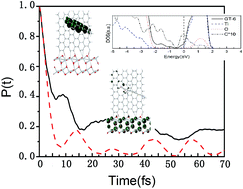How does graphene enhance the photoelectric conversion efficiency of dye sensitized solar cells? An insight from a theoretical perspective†
Abstract
The main goal of this work is to clearly answer the question from a theoretical perspective: how does graphene enhance the photoelectric conversion efficiency in the semiconducting layer of a dye sensitized solar cell? Several arrangements of the graphene layer between the dye molecule and the TiO2 (101) surface are carefully studied and discussed. The dynamic interfacial electron propagations are simulated with consideration of the underlying nuclear motion effect. Theoretical investigation shows that graphene can speed up the electron injection from the dye molecules to the semiconductor layer, only when the graphene sheet is bonded to the TiO2 surface via C–Ti bonds. The excited electrons of the dye molecules on the graphene sheet will be rapidly injected into the semiconducting layer. Additionally, if the graphene sheet is parallel to the TiO2 surface, the free electrons on graphene can only hop onto the TiO2 surface in a relatively long tunneling period. Therefore, graphene in this case mainly plays the role of a shielding layer for preventing the recombination of the electrons injected into TiO2 and the electron holes remaining on the dye molecules or in the electrolyte. The combination of these two mechanisms indicates that graphene layers in the proper conformation can effectively improve the photoelectric conversion efficiency of a dye sensitized solar cell.



 Please wait while we load your content...
Please wait while we load your content...